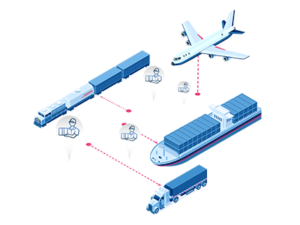In the shipping process, there is a lot of uncertainty because the shipping procedure is drawn out, difficult and error prone. Due to this uncertainty, it is important to keep all your stakeholders updated about the progress of their shipments.
Here’s how container tracking can be useful to streamline freight forwarding operations.
What are shipping containers?
Shipping containers are sturdy metal boxes that freight forwarders use to move products from one location to another. They are often constructed of steel and built to be sturdy enough to endure lengthy shipments.
Standardized containers have revolutionized the shipping and transportation sectors, making it simple to transfer goods by rail, road, and ship. This is because the containers are designed to simply fit onto various modes of transportation. Transporting over US $3 trillion worth of goods that pass through our transportation systems every year, has become more efficient and cost-effective because of container standardization.
Are you curious about how container tracking works? Let’s clarify the situation’s dynamics for you.
Tracking via communication
Container tracking was traditionally done through communication, it simply required monitoring each container’s status throughout the journey. Different checkpoints are utilized to guarantee consistent monitoring. For instance, in the case of road transportation, businesses communicate with truck drivers by email and phone to make sure that deadlines are met.
However, because the communication is spread through various channels, it was challenging to get real time shipment updates from time to time.
Verification via the Internet
Tracking online is an additional method of tracing containers during international sea transport. For example, the shipping company’s website lists specific checkpoints and offers crucial details like
1) The delivery and arrival times at the dock
2) Time of loading, as well as time of unloading the container
3) Time of loading on the transfer vessel
Real time Tracking
A GPS and satellite based technology called a container tracking system enables users to track the location of their cargo containers in real-time. Both land-based and ocean containers can be tracked with the container tracking system.

These tracking systems are widely used by freight forwarders and companies that frequently transport goods by road, sea, or rail. GPS trackers help keep track of things, but they also provide a real-time estimate of when crates will arrive and depart, allowing to take proactive decisions.
The real-time tracking itself is the last component of shipment visibility.
Benefits of Real-time container tracking
There are multiple benefits of implementing a real time container tracking system, here are the top ones
- Increased efficiency
Freight forwarders may easily see their inventory level at any time by using a centralized tool to track container movements. Operations will be made much more efficient and container usage can be easily monitored with the help of this information without having to check for updates constantly.
Container tracking systems offer useful information such as container utilization rates, and help users to identify potential cost-saving opportunities. Implementing a container tracking system can undoubtedly result in significant increases in operational effectiveness and higher productivity.
- Performance based on time
With real time container tracking shipment delays can be explained as to why shipments are not received by the date that was promised or projected to be. Freight forwarders can take action to address issues with delayed delivery if they can spot a pattern of a journey or a particular area that is likely to cause delays. This can help eliminate obstacles initially causing shipment delay and smoothen the overall operation process.
- Improve customer service
By having container tracking facilities in your freight forwarding business you will be able to provide better customer service by keeping your customers updated at all times all around the globe.
Real-time container tracking constantly allows customers to see where their freight is, when it is on the move and when it will arrive at the destination. This can be a huge advantage for your clients, as real time updates is one of the main elements for businesses in the supply chain industry.
- Actionable data insights
Making data-driven decisions that can be affected by container tracking systems is made possible by the overall container analytics provided to freight forwarders.
A precise tracking solution which collects data points for each of your shipments from all around the world, including when it leaves the port, arrives at the transhipment port will allow businesses to base their timely decision making processes based on real time statistics.
How can shipment visibility benefit your business?
Real time shipment visibility has become a core component for any freight forwarding business. It improves business operations with increased efficiency, improved customer services, provides data insights that drive proactive decision making and improves overall business performance based on time.

In order to provide real time shipment visibility many businesses in the industry have implemented shipment visibility tools that allows you to communicate with relevant stakeholders.
How can SFL Insights help you?
SFL Insights is a white label web/mobile application solution for CargoWise Powered freight forwarders to provide your clients increased shipment visibility from anywhere with any device.
CargoWise users can keep a close eye on their goods in real time, facilitating activities in the freight forwarding sector that may otherwise result in shipment delays and various other complications.
With SFL Insights you can provide milestone updates, track on map, documents sharing and uploads with real time communication.
Reach out to SFL Insights for a free demo.



